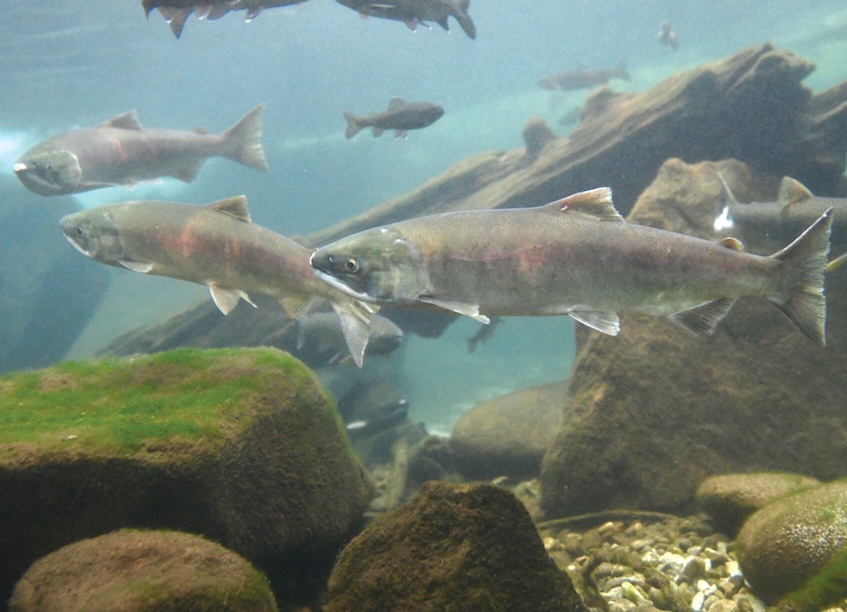forum
library
tutorial
contact

Abundant Sockeye Returns
Expected in Sawtooth Valley
by Tony Tekaroniake Evans
Idaho Mountain Express, August 5, 2022
|
the film forum library tutorial contact |

|
Abundant Sockeye Returns
by Tony Tekaroniake Evans
|
Salmon counted at Lower Granite Dam third highest since 1975
 The first two sockeye salmon completed the 900 mile swim from the Pacific Ocean to the Sawtooth Basin on July 28, about a week earlier than usual.
The first two sockeye salmon completed the 900 mile swim from the Pacific Ocean to the Sawtooth Basin on July 28, about a week earlier than usual.
The early arrivals were met with optimism by the Idaho Department of Fish and Game, which said the fish appear to be harbingers of "the largest sockeye return in years."
"As of July 28, there were 2,041 sockeyes counted at Lower Granite Dam about 30 miles downstream from Lewiston, which is nearly three times the 10-year average and the third-highest on record since counting began at Lower Granite in 1975," the department said in a statement this week.
The return migration from the Pacific to the species' spawning areas in the Sawtooth Basin is an arduous one, made far more challenging decades ago when a series of dams built on the Snake and Columbia rivers led to the fish's endangered species status in 1991. The endangered listing was initiated by the Shoshone and Bannock Tribes.
"Historically, about 50% to 60% of the sockeye that cross Lower Granite reach the Sawtooth Basin," Fish and Game said. Those fish still have about 450 miles remaining to complete their journey to the headwater basin of the Salmon River north of Ketchum, a journey made more perilous by low water in the Snake and Salmon rivers and warm temperatures that "can slow their progress and make their final migration ... more difficult."
High water temperatures last year prompted Idaho Fish and Game biologists to trap and truck sockeye at Lower Granite Dam and bring them to the Eagle Hatchery near Boise to ensure that some would be available for spring spawning.
To save the species from extinction, biologists in the 1990s initiated a captive broodstock program with 16 adult sockeye -- 11 males and five females -- that returned to Idaho between 1991 to 1998.
"Through advanced aquaculture techniques, the program has retained about 95% of the species' genetic variability and gradually increased the annual returns to Idaho," the department stated. "Sockeye returns to the Sawtooth Basin have fluctuated wildly over the last decade from a low of 17 in 2019 to a high of 1,579 in 2014."
Idaho Rivers United Conservation Associate Stephen Pfeiffer monitors sockeye returns closely. He said by Aug. 1 that a total of eight sockeye, including three natural spawners, had returned to the Sawtooths.
"We should see hundreds more return in the next few weeks," Pfeiffer said. "I would expect somewhere around 1,000 sockeye to the Stanley Basin, the vast majority of which will be hatchery fish."
Pfeiffer said he attributes this year's big return to decades of good sockeye program work from Idaho Fish and Game and the Shoshone-Bannock Tribes, and the fish taking advantage of favorable ocean conditions.
"The ocean conditions have acted like a rising tide and raised all ships: sockeye, Chinook, and steelhead return numbers are all up this year," Pfeiffer said.
Yet final recovery goals for the fish species appear to be a long way off.
"Poor in-river survival, as a result of the eight dams on the Columbia-Snake, is still the main recovery impediment for wild salmon," Pfeiffer said.
The regionally established goal for sockeye is 9,000 natural [spawning] fish per year to the Stanley Basin as a 10-year average, and Endangered Species Act delisting calls for 2,500 per year.
Pfeiffer said with ocean conditions oscillating from favorable to unfavorable, the only modeled recovery action that can halt long-term declines and rebuild populations of sockeye (as well as Chinook and steelhead) is removal of the four Lower Snake River Dams.
A matrix of National Oceanic and Atmospheric Administration salmon ecosystem indicators shows a recent increase in food availability and cooler ocean temperatures in the Pacific Ocean.
Related Pages:
Count the Fish Idaho Fish & Game (1977-2021)
learn more on topics covered in the film
see the video
read the script
learn the songs
discussion forum
